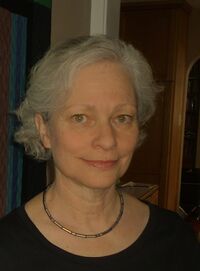Pamela Gorkin

Hi Pamela! We look forward to your talk i November!
When did you feel mathematics was something you were really interested in?
In 7th grade, we were “tracked” for the first time: This meant that a few groups of students were taught algebra a year before the others. The teacher for the group was very demanding and widely feared. I loved the teacher and the challenge. I also realized, for the first time, that I might be good at it.
Why do you find mathematics so interesting and fascinating?
I’m a pure mathematician by training, but I’ve also studied quite a bit of statistics. In statistics, it’s the applications I love. In mathematics it’s the logic, the precision, and the language. It’s being able to take an argument and apply it to something else – something unexpected. Sometimes, it’s the simplicity of the argument that’s so fascinating, like Dirichlet’s Pigeonhole Principle: Everyone knows that if you have more pigeons than holes, then two pigeons must end up in the same hole, but it takes a mathematician to realize that the Pigeonhole Principle implies that if there are two or more people at a party, then there are at least two people who are friends with the same number of people at the party. And a mathematician would realize that it all comes down to your definition of friend.
Did you have a role model within mathematics or science when you were young?
When I look back, I see that there wasn’t anyone in my life at that time who knew what mathematics was or who could understand what I loved about it. There were people who encouraged me, but there was no one who could serve as a role model.
Do you have a role model or an idol today? Who? Why is she/he your role model/idol?
I certainly have people I admire and there are two, in particular, who were exceptional research mathematicians, teachers and mentors. The first is my advisor, Sheldon Axler. He is now Dean of the College of Science and Engineering at San Francisco State University. He was just a fabulous teacher, researcher, and thesis advisor. The second was Paul Halmos, who was also known as an excellent researcher, but perhaps even better known as a great expositor of mathematics. (I just wrote this sentence and then looked up his biography on Wikipedia, where it says, “He was also recognized as a great mathematical expositor.”) I was a student in a functional analysis course that he taught at Indiana University. The mathematics was fascinating, but so was the way he taught the class. Halmos encouraged and supported me at a time when I wasn’t sure that I would be able to do mathematical research.
How would you explain the core of mathematics?
Paul Halmos once said, “The heart of mathematics is its problems.” Mathematics is the search for structure, patterns, specific examples, and generalizations. It is a search for understanding and one that requires logic, reasoning, and hard work. Above all, however, good mathematics requires a creative mind.
Your favorite book in mathematics?
I love many books in mathematics: I love Axler’s books for their clarity, the books Halmos wrote for their creativity and lively style, Tom Körner’s books for their unusual humorous approach to mathematics, and I love Nicholas Young’s little Hilbert space book -- it says exactly what it needs to say, no more and no less. But my favorite book in mathematics is not a mathematical book. It’s A Wrinkle in Time, by Madeleine L’Engle. The book, written in 1959 and 1960, had a female main character who traveled through time and space. There was a discussion of dimensions (the fourth and fifth dimensions) and tesseracts, and her mother was not only beautiful, she was a scientist. I was about nine years old when I read it the first time and it made me think that I could be anything.
What are your expectations for the Sonja Kovalevsky days?
I’m looking forward to it – particularly getting to know the students. In addition, Sonja Kovalesky is a woman all mathematicians admire and, had I known more about her as a child, she would have been a perfect role model. There are celebrations in the United States, but it is really exciting to participate in a Swedish conference in her honor.
What do you do in your spare time?
Spare time? Hmmmm…I like to read, watch films (particularly independent films), and I love modern art. I also travel a lot, for work and to see my family. When I’m not traveling, I would say I spend a fair amount of my spare time cooking and sharing what I cook with friends.
